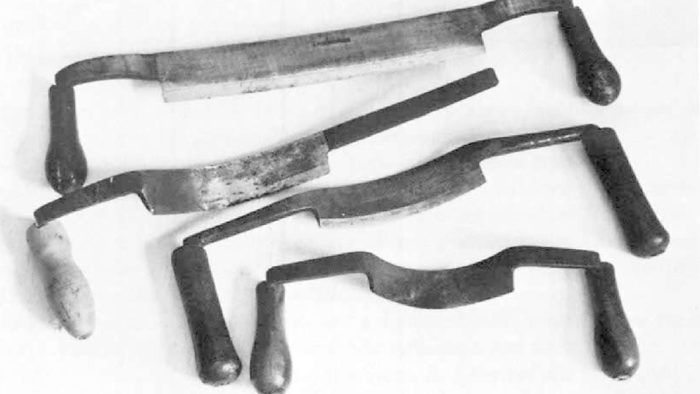
Synopsis: Drew Langsner says drawknives are among the most versatile tools available to woodworkers, because they’re fast and easy to use for roughing out stock and for some kinds of finish work. Langsner shares information on how to find good steel for forging one, how to select a good one from a catalog, variations in the angle between the handles and the blade depending on how it’s used, and how he uses one. He explains how to sharpen a drawknife using a sandstone wheel or a flat whetstone. He describes how to use them safely and how to do various operations — roughing out straight-grained wood, shaving a chair leg, and shaping a flare.
Although many woodworkers own a drawknife, I am continually surprised to learn how seldom these tools are used. Drawknives are among the most versatile handtools available to woodworkers. They are fast and easy to use for roughing out stock and for some kinds of finish work. Traditionally drawknives were needed by a wide range of skilled woodworkers. I first used one during a summer of intensive training with a Swiss cooper. Other craftsmen who once depended on drawknives include furniture makers, carpenters, turners and wheelwrights. Drawknives are perfect for dressing shingles, making tool handles, debarking poles and pointing fence posts and pickets. They’re also excellent for quickly making odd-size dowels, pegs and wedges, especially from straightgrained, riven stock. There’s no better tool for adding a decorative chamfer to furniture parts and even house parts.
A drawknife is a viable alternative (or addition) to machine tools for various kinds of work, especially for individual pieces or small production situations. Chairmaker John D. Alexander, Jr., for example, used to work with sawn lumber which he turned on a lathe. His book, Make a Chair from a Tree: An Introduction to Working Green Wood (The Taunton Press, 1978) gives good reasons for his becoming a drawknife convert. Ring-porous hardwoods can be split out quickly and shaved with a drawknife to graceful dimensions while maintaining the strong, continuous grain structure. There is also the pleasure of working in a shop with quiet tools that run on human energy. And the waste from a drawknife is shavings, not sawdust that can cause various respiratory problems.
Old drawknives were often homemade or produced in small runs at local blacksmith shops. A good source of steel for forging a drawknife (see “Basic Blacksmithing,” FWW #9, Winter 77 ) is a worn-out file or rasp. Grind off the file teeth along the drawknife cutting edge before doing any forge work.
Early tool catalogs list a wide variety of drawknives for general and specialized uses. The basic drawknife has a straight blade, 6 in. to 10 in. long, with a handle at either end, usually at right angles and in the same plane as the blade. Most often only one side of the blade is beveled, though some old drawknives have symmetrically shaped blades, beveled like a knife or an ax. Slightly dished drawknives (with a bevel on the concave face) are used for dressing flat surfaces, such as the slats of a ladderback chair. Radically curved drawknives, called inshaves, can be beveled on either side. For hollowing (as for barrel staves) or quickly reducing the thickness of a board, a bevel on the convex surface is best. A bevel on the concave face is used for finer work.

From Fine Woodworking #25
For the full article, download the PDF below:
Fine Woodworking Recommended Products

Marking knife: Hock Double-Bevel Violin Knife, 3/4 in.

Starrett 4" Double Square

Honing Compound





















Log in or create an account to post a comment.
Sign up Log in